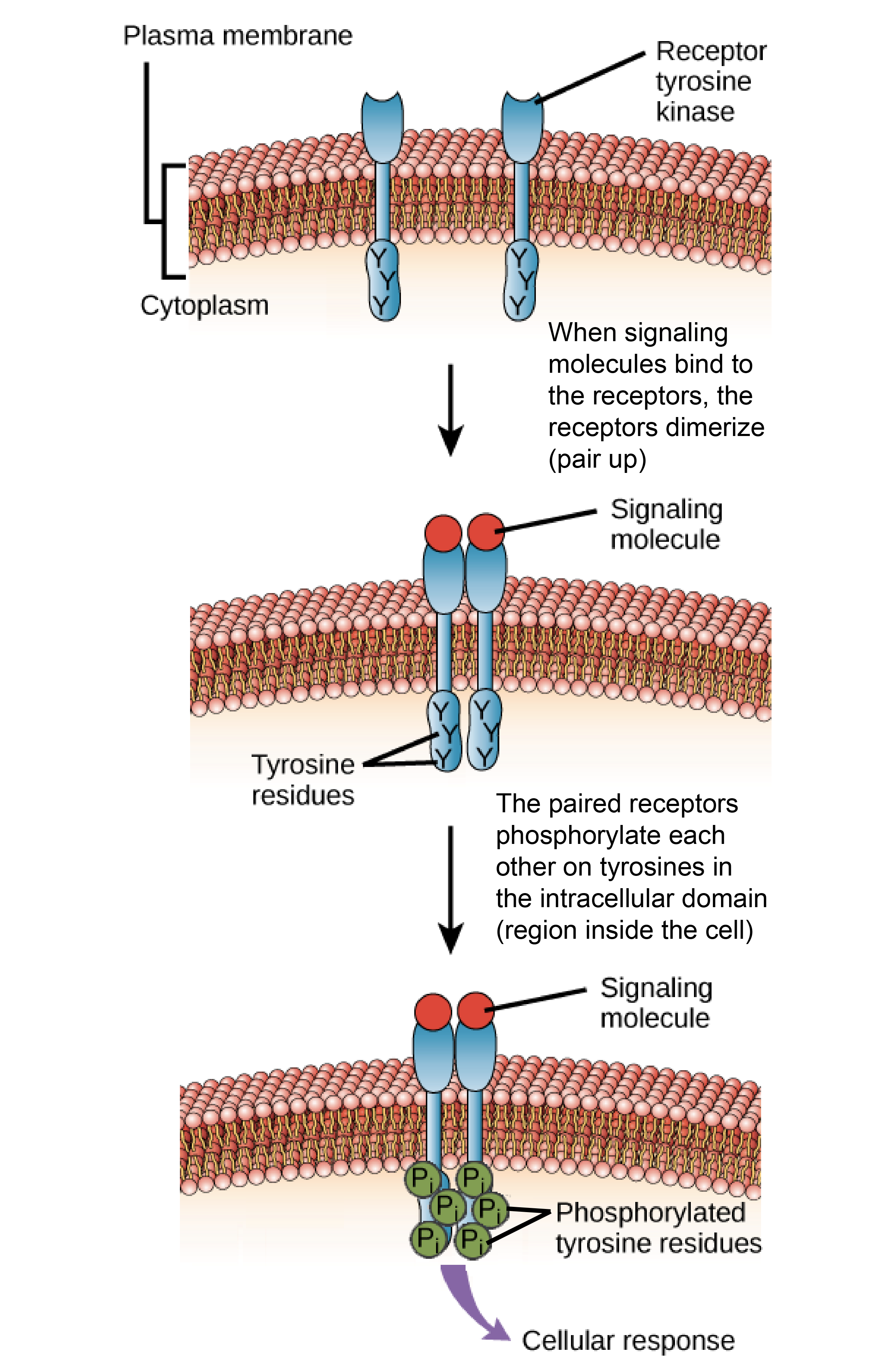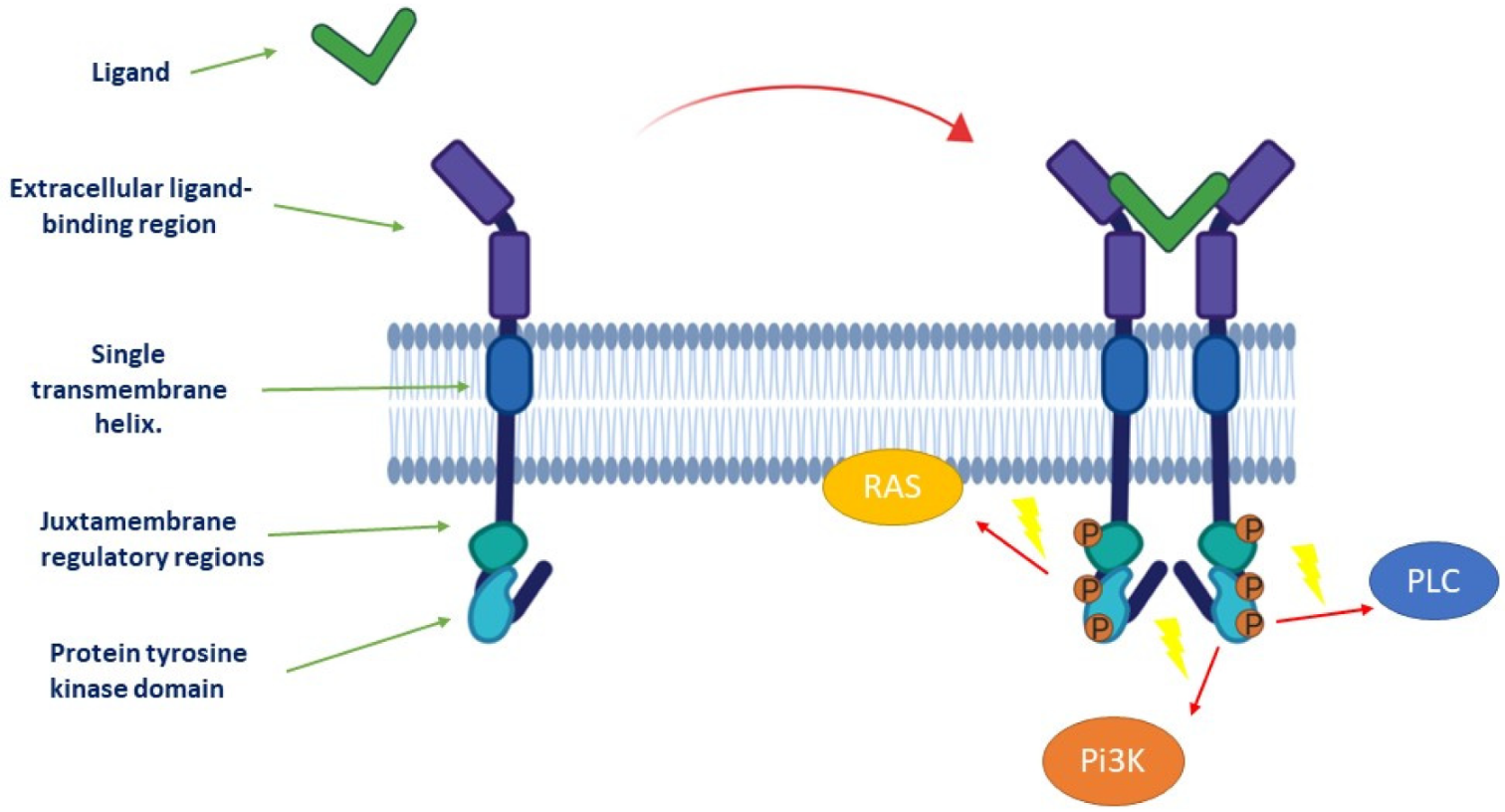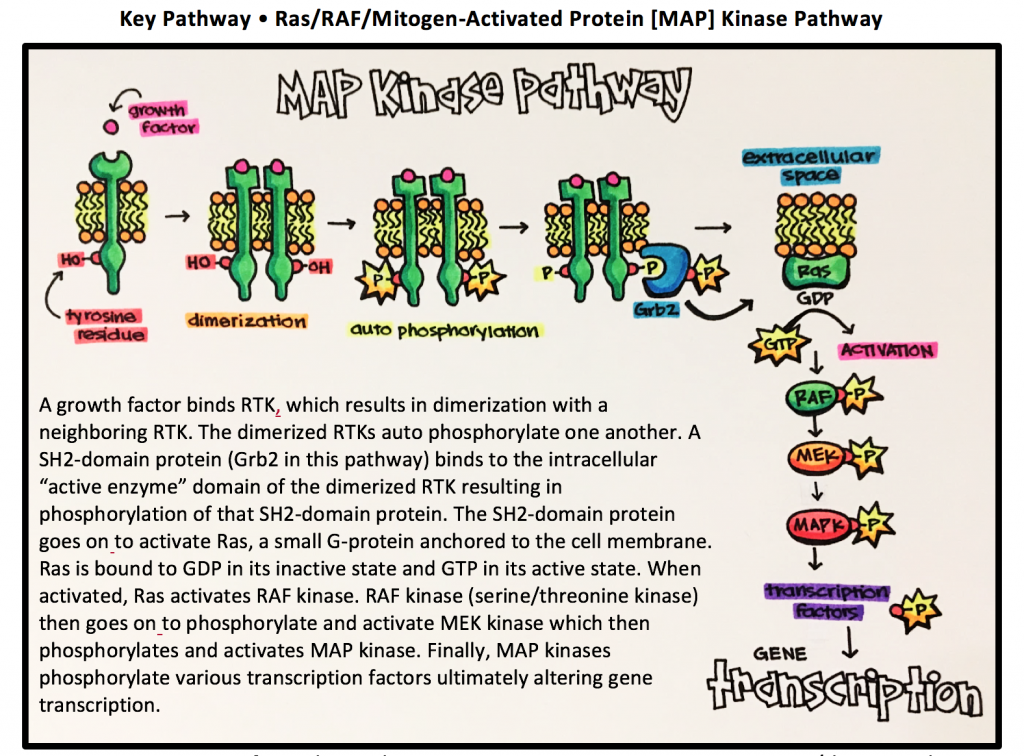Ligand Binding to a Receptor Kinase Results in
Binding of cytoplasmic signaling molecules. Ligand binding induces a conformational change in the ectodomain leading to the reorientation of the intracellular kinase domains resulting in the activation of the asymmetric kinase dimer.

Propagation Of The Signal Biology For Majors I
Ligand binding to the receptor domain regulates the ratio of kinase to phosphatase activities of the signaling domain of the hybrid Escherichia coli transmembrane receptor Taz1 J Mol Biol.

. Ligand binding to a receptor kinase results in. As signaling proceeds activated receptors will bind to phosphotyrosine-binding proteins such as actin Cbl and Grb2 resulting in the oligomerization of the EGFR. Phosphorylation of the cytoplasmic domain of the receptor.
Ligand reaches its target cell and binds to a specific receptor. Of the 90 unique tyrosine kinase genes identified in the human genome 58 encode receptor tyrosine kinase proteins. Here we describe a signaling pathway whereby LRP1 transactivates Trk receptors.
Biology questions and answers. The ligands bind to RTKs promoting RTK dimerization and in some cases oligomerization which brings the two kinase domains in close proximity. All of these answer options are correct.
What mutation is commonly found in RAS genes in cancer cells. How does ligand binding to a receptor tyrosine kinase result in the activation of RAS. While the classical mechanism for receptor tyrosine kinase activation ligand-induced dimerization is essential for all these ligands to activate the receptor Kovacs et al 2015.
We show here that RET can be directly activated by. Recent studies applied a combination of multi-channel fluorescence imaging with microarrays to study molecular interactions. Receptor tyrosine kinases are the high-affinity cell surface receptors for many polypeptide growth factors cytokines and hormones.
A change in gene expression resulting in cell division What causes the inactivation of a G protein. However the number of experimental structures is scarce. How does this mutation influence RAS activity.
Protein microarrays such as kinase and G protein-coupled receptor GPCR arrays have been designed and applied to analyze ligand binding Analysis of protein kinase A and leukocyte-specific protein tyrosine kinase with 80 kinase. FGF ligand FGF receptor FGFR Plasma membrane Active FGFR converts Ras from the inactive GDP-bound form not shown to the active GTP- bound form. RET is activated when the binding of a growth factor such as artemin ART brings about assembly of a pentameric complex that includes two copies of RET plus two copies of the GPI-linked co-receptor GFRα3.
Which of the following is not an essential element involved in communication between all cells. Via signal amplification the number of signaling molecules is increased at every step of the signal cascade. Receptor tyrosine kinases have been shown not only to be key regulators of normal cellular processes but also to have a critical role.
Ligand-induced oligo-merization required tyrosine kinase activity and nine different tyrosine kinase substrate residues. Ligand binding to the c-terminal ligand binding domain is an important regulatory event in ar function resulting in a conformational change that disrupts an intramolecular interaction between the amino terminus and the carboxy terminus initiates posttranslational modifications dissociates the ar from heat shock proteins hsps and results in. What is the end result of activation of the MAP kinase pathway.
Found that heparin bound directly and with high affinity to a specific region in the extracellular domain of ALK. Signaling by transmembrane receptor kinases which are composed of an extracellular ligand-binding domain a single transmembrane helix and an intracellular kinase domain is fundamental to. Given that ligand binding is essential for the rapid internalization of epidermal growth factor receptor EGFR the events induced by ligand binding probably contribute to the regulation of EGFR internalization.
However little is known regarding how ligand binding to LRP1 initiates signaling or controls complex processes such as neurite outgrowthWe previously showed that upon binding to LRP1 α 2-macroglobulin α 2 M. Binding of a ligand to a receptor changes its shape or activity allowing it to transmit a signal or directly produce a change inside of the cell In this section well look at different types of receptors and ligands seeing how they interact to turn information from outside the cell into a change inside the cell. Receptor tyrosine kinases RTKs including anaplastic lymphoma kinase ALK are important during development and regeneration and are often aberrantly activated in cancer.
Human G-protein coupled receptors GPCRs convey a wide variety of extracellular signals inside the cell and they are one of the main targets for pharmaceutical intervention. This indicates that the binding of signaling molecules to activated EGFRs results in. Rational drug design requires structural information on these receptors.
Trk receptor transactivation was necessary for activation of Akt and extracellular. We used molecular dynamics simulations to investigate this difference. Binding of tissue-type plasminogen activator or α 2-macroglobulin α 2 M to LRP1 resulted in Src family kinase SFK activation and SFK-dependent Trk receptor transactivation in PC12 cells and neurons.
As a result the kinases phosphorylate each other to activate each other. The RET receptor tyrosine kinase is an example of such a multi-component receptor. The cytoplasmic tail of LRP1 contains binding sites for signaling adaptor proteins such as Shc JIP1 c-Jun N-terminal kinase JNK interacting protein 1 and JIP2.
FGF ligand binding to the FGFR results in dimerization activation of FGFR. This gap can be filled by computational models based on homology. RhoA-GTP dissociates from RhoA-GDPi allowing RhoA to bind downstream targets.
Ligand binding to G-protein coupled receptors results in conversion of RhoA-GTP to RhoA-GDP. This of receptor structure in the plasma membrane is the orientation may be sensitive to both the stoichiometry of observation that ligand binding induces the formation ligand binding and the phosphorylation state of the re- of higher order clusters of EGFR tetramer or higher ceptor 26 28. As a result the ligand-binding pocket is slightly compressed when TGF-α is bound.
For RTKs ligands are generally small proteins between 50 and a few hundred amino acids long which are secreted by cells. All of these choices are correct. ALK is an orphan RTK with no known ligand.
These events include receptor dimerization activation of intrinsic tyrosine kinase activity and autophosphorylation. A conformational change in the cytoplasmic domain of the receptor Ligand binding to a receptor kinase results in. Ligand binding induced the formation of receptor oligomers which were found in both the plasma membrane and intracellular structures.
This activates a signaling cascade involving intracellular enzymes and molecules second messengers which again leads to a specific reaction.

Cell Signaling By Receptor Tyrosine Kinases Cell

Ligands Receptors Article Khan Academy

Tyrosine Kinase Receptors An Overview Sciencedirect Topics

Multisignaling Receptors And Biased Signaling The Binding Of A Download Scientific Diagram

Ligand Induced Receptor Mediated Dimerization And Activation Of Egf Receptor Cell

Upon Ligand Binding Receptor Tyrosine Kinases Rtks Dimerize And Download Scientific Diagram

Upon Ligand Binding Receptor Tyrosine Kinases Rtks Dimerize And Download Scientific Diagram

Schematic Representation Of Receptor Tyrosine Kinase And Downstream Download Scientific Diagram

Cancers Free Full Text Tyrosine Kinase Inhibitors In Cancer Breakthrough And Challenges Of Targeted Therapy Html

Enzyme Linked Receptor An Overview Sciencedirect Topics

Receptor Tyrosine Kinase An Overview Sciencedirect Topics

13 Enzyme Linked Receptors Principles Of Pharmacology Study Guide
/11614.png.aspx)
Rtk Ctk Kinase Cell Based Assays

Signaling Cascade Of Jak Stat Pathway Binding Of The Ligand To Download Scientific Diagram

Tyrosine Kinase Receptors An Overview Sciencedirect Topics

13 Enzyme Linked Receptors Principles Of Pharmacology Study Guide

Signal Transduction Pathway Cell Signaling Article Khan Academy


Comments
Post a Comment